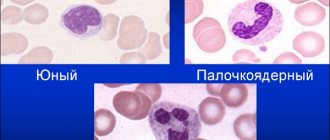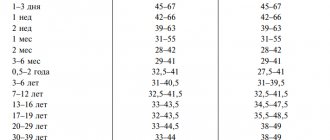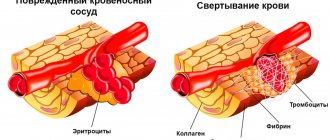In medical practice, one of the indicators of a person’s health status is the appointment of laboratory tests, the results of which determine the correct diagnosis. One of the basic ones is a blood test, which is mainly prescribed to patients whenever they visit a doctor with complaints about their health. The doctor deciphers the tests, however, often certain indicators raise a lot of questions in the patient, especially when trying to interpret them independently.
One of the fundamental criteria for analysis is the value of ROE, which is difficult for a person not associated with medical science to understand, as well as to determine the presence of difficult aspects based on this indicator. In this article we will tell you what the abbreviation ROE means, what is the root cause of fluctuations in this indicator, we will consider what the criterion for ROE in the blood should be, its norms for women, the stronger sex and children. Additionally, we will analyze in which cases non-compliance of the ROE with standards acts as an indicator of health difficulties and requires qualified assistance from specialists.
What does the abbreviation ROE stand for?
A superficial excursion into physiotherapeutic theory will help you understand what ROE is in a blood test. ROE is a complex abbreviated medical phrase interpreted as “erythrocyte sedimentation reaction.” Nowadays, analysis results often contain the abbreviation ESR, which indicates the erythrocyte sedimentation rate, however, in reality both indicators are identical.
When checking the settling criterion, no reaction occurs; the essence of establishing this indicator is to identify the ability of particles to sink in a glass flask under the natural pressure of gravity, which led to updating the abbreviation, replacing the word “reaction” with “speed”. The laboratory essence of measuring ROE is as follows: the rate at which red blood cells settle in a specific glass container is recorded in the number of millimeters, how much their level has decreased within one hour. Accordingly, the abbreviation ROE is outdated, however, it is still often used in blood test forms and medical documentation by “old-school” doctors.
Reasons for high ROE
An increased ROE does not always mean the presence of any pathologies in the body. If the indicators are elevated, it is necessary to exclude physiological causes of this phenomenon.
These include:
- Elderly age.
- Postpartum period.
- Menstruation.
- Puberty period.
- Pregnancy.
- State of stress.
- Taking estrogens and glucocorticoids.
About 5% of the world's inhabitants have abnormal ROE indicators from birth. Moreover, they do not have any chronic diseases or other pathologies that could contribute to this process. Why the analysis shows high numbers has not yet been established.
In other cases, it is important to contact your doctor, who will prescribe a number of additional tests for an accurate diagnosis.
An increased ROE is observed when:
- Inflammatory processes in the body.
- Infections.
- Serious lead or arsenic poisoning.
- After operations and other surgical interventions.
- With elevated cholesterol levels.
- Liver diseases.
- Anemia.
- Worm infestation.
- Significant blood loss.
- Hemolysis.
- Diabetes mellitus.
- Massive injuries and wounds.
- Hyperthyroidism or hypothyroidism.
- Kidney diseases.
Erythrocyte sedimentation
In most cases, ROE is increased in inflammatory and infectious pathologies. After competent antibacterial therapy, the indicator quickly returns to normal.
In such serious diseases as diabetes mellitus, anemia and hemolysis, ROE is increased over a long period, and is accompanied by a number of other unpleasant symptoms such as:
- Weaknesses.
- Loss of strength.
- Losing or, conversely, gaining weight.
High ROE is observed in diseases such as:
- Lupus erythematosus.
- Rheumatism.
- Arthritis.
- Dermatomyositis.
Pathologies associated with connective tissue and vasculitis are accompanied by long-term inflammatory processes. The analysis can be of high value over a long period of time. In this case, timely and competent treatment of the underlying disease is required.
Increased rates are observed in pathologies that cause tissue death. These include:
- Tuberculosis.
- Heart attack.
- Diseases with the formation of pus.
- Intestinal pathologies.
If the indicator is sharply increased to values from 60 to 80, then the presence of tumors can be suspected. At the initial stage of tuberculosis in an adult, the indicators may be slightly increased, but in the absence of treatment they rise to 90. With various infections, the ROE does not increase immediately, but after a few days.
A similar situation occurs with inflammation of the appendix. In a child, ROE is most often increased in inflammatory and infectious diseases.
ROE is always higher than normal in rheumatism and arthritis. During the last trimester of pregnancy, the ROE may exceed 40-50 mm/hour, which is normal. It may take several months for the number to return to normal.
A woman’s weight plays an important role in this: with low body weight, the indicator may not exceed 30, and with excess weight during pregnancy, it can reach 70.
When ESR decreases, several components of correct erythrocyte sedimentation are not in order
Diseases serving as an indicator for the study
Laboratory diagnosis of ROE indicators can be prescribed by the attending doctor in the presence or suspicion of the presence of such painful conditions:
- inflammatory or infectious processes;
- the presence of pathologies that are characterized by complications in the form of necrosis of tissue joints; medicine includes heart attacks, malignant tumors, purulent formations, tuberculosis, and intestinal diseases;
- connective tissue diseases such as rheumatism, arthritis, lupus, dermatitis;
- diseases that are based on metabolic and hormonal imbalances; the main diseases in this category that affect ROE are diabetes mellitus, increased or decreased production of hormones;
- anemic disease, significant blood loss and hemolysis are the primary sources of a decrease in the number of erythrocytes, and, accordingly, the cause of a decrease in ROE;
- nephrotic syndrome, which provokes the progression of liver disease;
- female changes in the body due to the menstrual cycle, menopausal changes, pregnancy or after childbirth;
- the period after surgery or surgical intervention are direct indicators for monitoring ROE values;
- measurement of ROE is indicated for increases in cholesterol;
- prolonged use of medications;
- intoxication of the body with life-threatening chemicals.
It is worth noting that for different diseases, the pattern of changes in ESR may vary depending on the stage of the disease, as well as the characteristics of its course. Only a specialist can competently interpret the picture of ESR variations, in accordance with additional examinations, patient complaints, and the clinical picture of the disease.
Why does the parameter value increase?
The reasons why the value of the ESR parameter increases in women is normal:
- menstrual period;
- use of oral contraceptives;
- pregnancy;
- postpartum period.
In women over 50 years of age, the increase in ESR is associated with hormonal changes in the body as menopause approaches.
In a child, the ESR value depends on his age. In a newborn, the maximum value is 2.8 mm/h, which is associated with a very low protein concentration in the blood, and therefore the lack of conditions for red blood cells to quickly settle. Since blood viscosity increases with the development of a child, by the age of 14 this figure in girls becomes 2-15 mm/h, in boys - 1-10 mm/h.
Factors determining the erythrocyte sedimentation rate
The ROE criterion, with the exception of blood clotting characteristics, is influenced by two fundamental factors:
- number and structure of erythrocyte type cells;
- quantitative and qualitative composition of plasma.
In a healthy state, red blood cells have the characteristic of antimagnetism, due to the negative charge on their surface. Normally, red blood cells circulate along the highways under the influence of a repulsive force. Activation of immune mechanisms directly affects the increase in quantitative indicators in the composition of the plasma of immunoglobulins, which, in turn, provokes a decrease in its density and ductility. The consequence of this process is a change in the charge on the surface sphere of the erythrocyte, which results in the formation of enlarged and massive erythrocyte compounds, which sink under the influence of gravity in an accelerated manner.
The opposite reaction is characterized by a precedent when plasma becomes more concentrated than it should be according to natural standards. In such a situation, red blood cells, compared to plasma, lose weight and, accordingly, remain in a “suspended” state for a longer period, which is characterized by a decrease in ROE.
Reasons for the increase
Often, a high blood ROE criterion is an indicator of the presence of pathological conditions. The reasons for the critical increase in ROE in the blood may have the following etiology:
- infectious, autoimmune or oncological diseases;
- aggravated inflammatory processes with varied localization and typology;
- serious blood loss, hemorrhage or anemic conditions;
- uncontrolled intake of medicinal substances, which gave rise to transformations in the composition of the blood at the molecular level.
It is not always possible to determine what causes an increase in ROE in test results using one blood test; additional examinations of the body may be necessary to diagnose the original source of the precedent. Often, ROE criteria increase slightly against the background of standard physiological changes in the body and are not a reason for panic; they act as a standard reaction and are considered normal values. The physiological root causes of an increase in ESR may include changes in people of retirement age or in children against the background of age-related changes, during periods of hormonal changes in the fairer sex as a result of taking hormonal substances, poor nutrition or incorrect testing.
Reasons for the downgrade
ROE slowdowns are a rarer phenomenon in practical medicine. Often, such precedents in non-critical variations are not a cause for concern; they may indicate normal overwork of a person, minor intoxication of the body or dehydration.
Critical decreases in ROE are often an indicator of the progression of jaundice, hepatitis of various types, sickle cell anemia, the presence of a tumor, which requires additional examination of the patient.
Reasons for the increase
The ESR indicator can be increased as a result of physiological processes and pathological changes in the body.
ROE (normal blood levels in women by age), a table with the value of which shows their changes, can reach 45 mm/hour. Thus, during puberty in adolescents, ROE can normally reach up to 19 mm/hour, during pregnancy up to 45 mm/hour, during menopause and menopause up to 30 mm/hour, in women with impaired ovarian function up to 40 mm/hour.
Physiological reasons for an increase in ROE are also allergic reactions, various diets, and fasting.
A pathological increase in ROE occurs in many diseases:
- Inflammatory diseases of various etiologies. Joint pathologies—arthritis, arthrosis, rheumatism, inflammatory-degenerative diseases of the spine.
- Viremia of various origins. Flu, ARVI, herpes diseases.
- Bacterial infections and their complications. Tuberculosis, tonsillitis, bronchitis, pneumonia.
- Endocrine and autoimmune diseases. Diabetes mellitus, systemic lupus erythematosus, thyrotoxicosis.
- Ulcers, abscesses, sepsis.
- Inflammatory diseases of the female genital area. Endometriosis, ovarian cysts, inflammation of the appendages and fallopian tubes.
- Hematopoietic disorders.
- Exacerbations of chronic diseases—pancreatitis, cholecystitis, stomach ulcers.
- Long periods of high ROE may be a sign of the onset of an oncological process.
Methodology for diagnosing the ROE coefficient
To specify the ROE coefficient in laboratory practice, two methodologies can be used: the Panchenkov method or the Westergren version. Both methods are not nonspecific; they involve taking capillary blood in the first case and taking venous blood when using the second method. The methodologies differ from each other exclusively in the test tubes used to measure the parameter, which vary in volume and scale.
In the first case, a test tube is used, which is ten centimeters in length. To obtain the final data, blood is mixed with an anticoagulant in a certain proportion, left for an hour, after which the measure of erythrocyte sedimentation is assessed.
Westergren's methodology involves settling the substance in a test tube, the length of which is twenty centimeters, while the blood for settling is dissolved with sodium citrate. As in the previous case, the results of the study are assessed after an hour.
Regardless of which method is used to determine erythrocyte sedimentation, the result will be identical if the procedure is performed correctly.
Features of preparation for testing
The value of ROE in a blood test can vary depending on many internal and external factors. In order to obtain the correct designation for the rate of red blood cell descent, it is important for the patient to adhere to certain rules before taking the test.
When studying using the Panchenkov method, doctors recommend that the patient take the test on an empty stomach, in the first half of the day, and the day before the study, rationalize his diet, remove fatty, spicy and salty foods from the menu.
When planning a study using Westergren’s methodology, it is necessary to adhere to similar recommendations, while the period of abstinence from irrational food should be increased to two days, and food consumption should be excluded twelve hours before the planned procedure.
It is worth considering that drinking tea, coffee or other drinks, except water, in the morning can affect test results. In addition, experts recommend not smoking for an hour before the procedure, since nicotine may also affect the results of the study.
Physiological normative standards and pathological variations of the ESR criterion
Let's consider what the ROE coefficient should be in a healthy person, depending on his gender and age. The standards for the erythrocyte sedimentation reaction have a large-scale amplitude of fluctuations and differ in accordance with physiological characteristics, the nature of human nutrition, exogenous and endogenous circumstances affecting the functioning of the body.
The differentiation of ROE indicators looks like this:
- For men and teenage boys, the norm for ROE in the blood is from one to ten millimeters per hour.
- The cell sedimentation rate for women and teenage girls is considered standard if its criteria range from two to fifteen units.
- For people of retirement age, the ROE rate ranges from fifteen to twenty millimeters per hour.
- The norm for children under ten years of age is determined regardless of gender, differentiated by age criterion. For newborns, ROE variations from three to four are standard, while the norm for infants and children under ten years of age is from three to ten and from four to twelve units, respectively.
If the ESR results do not meet the standard, in medicine it is customary to talk about a slowdown or acceleration of the erythrocyte sedimentation reaction, which can act as an identifier of abnormal phenomena in the body of the person being studied. The phenomenon of non-compliance with the standard criterion for sedimentation of erythrocyte compounds is characterized by a change in their properties at the molecular level, which makes them temporarily defective. Deviations of ESR from the standard should be a reason to visit a doctor in order to identify the cause of this precedent.
What is ROE and its significance for the body
What is RO ESR (ESR)—erythrocyte sedimentation rate. The analysis is one of the main basic blood tests. A referral for examination is issued upon initial consultation with a doctor, before medical procedures or surgical interventions.
Laboratory essence of the method: healthy red blood cells precipitate slowly. Aggregated (glued) red blood cells have a greater mass and settle at a faster rate. Factors that indicate the activation of the immune response to pathology in the body lead to the sticking of red blood cells.
The erythrocyte sedimentation reaction is a nonspecific laboratory indicator that indirectly indicates pathological disorders in the body. Based on ROE, a final diagnosis cannot be made, but the direction of further research can be determined.
Fictitious increase in indicators
An increase in the ROE coefficient beyond the limits based on age and gender does not always indicate the presence of pathology in the patient’s body. There are cases when elevated numbers are false indicators of illness. The following factors can provoke this result:
- the patient has varying degrees of obesity, unhealthy diet;
- elevated cholesterol levels, which can cause an increase in ESR;
- the patient is taking vitamin complexes or drugs of a medicinal group with a high content of vitamin A, as well as using oral contraceptives;
- recent vaccination against hepatitis;
- features of the female body;
- the presence of regular depressive and stressful overstrains.
The task of the attending doctor in such a situation is to correctly interpret the test results, and if there are doubts about the reliability of the data, send the person for re-analysis and prescribe auxiliary studies.
Reasons for low ROE
It is necessary to show concern not only with high, but also with too low indicators.
Most often this occurs when:
- Muscle dystrophy.
- Presence of nervous disorders.
- Jaundice.
- Hepatitis.
- Cholecystitis.
- Circulatory failure.
- Leukemia.
- Fasting.
- Heart failure.
- Vegetarianism.
- Taking steroid hormones.
- Treatment with non-steroidal anti-inflammatory drugs.
ROE below 2 mm/h may indicate the presence of serious diseases. If it is slightly reduced, then it is necessary to change the diet and add iron and protein to it. Very often, this situation occurs in women who have lost weight dramatically and adhered to strict diets.
A decrease in erythrocyte sedimentation rate is extremely rare.
Increased swelling does not always mean that a person is sick and an inflammatory process is occurring in his body. In order to accurately decipher the analysis and understand why the ROE indicator is increased, you need to visit a specialist. Only with the help of additional tests and studies can an accurate diagnosis be made and the correct treatment prescribed.
Specifics of ROE normalization
The most common cases in medical practice that cause concern are cases where blood ROE exceeds regulatory standards. With such results, patients naturally have a question about how to lower ESR, however, there is no clear answer to it, since the specifics of eliminating this problem depend on a variety of factors.
The specifics of reducing ROE include:
- diagnosing the cause of the precedent;
- therapeutic measures aimed at eliminating the basal disease;
- systematic monitoring of indicators until they are restored to normal standards.
People whose ESR is slightly higher than normal and does not have pathological support may be recommended to take preventive measures, which include the following:
- Rationalization of your diet by avoiding foods that are harmful to the body, enriching your diet with healthy foods, balancing your daily menu.
- Control of the daily routine with the correct alternation of work and rest, supplementing the regimen with daily walks in the fresh air.
- Refusal of addictions, the main ones of which are smoking and alcohol abuse.
- Maintaining a healthy lifestyle.
If the root cause of the increase in ESR is a consequence of pathological reactions in the body, the erythrocyte sedimentation rate can be reduced only after identifying and eliminating the key ailment. The methodology for reducing indicators depends on the severity of the underlying disease and may include both drug treatment with the prescription of antibacterial, anti-inflammatory and antihistamine drugs, and surgical intervention if necessary.
Traditional medicine also plays an important role in stabilizing ROE indicators. Let's look at how to reduce erythrocyte sedimentation in the blood using folk remedies effectively and without compromising your overall health. For this purpose, traditional medicine recommends the use of herbal decoctions and teas that have immunostrengthening and anti-inflammatory effects. Chamomile, calendula, linden, and sea buckthorn are considered the most effective in this area. Drinking raspberry tea with the addition of honey or lemon will have a positive effect on the body.
The following folk recipe perfectly helps improve immunity and reduces the growth of ESR: a mixture of chopped garlic (about one hundred grams) and lemon juice squeezed from five lemons, use one spoon before bed, first dissolving in water.
Not the least place in restoring the composition of the blood and its physiological characteristics is occupied by ordinary red beets. Beets can be added to your daily diet in raw or boiled form, or you can drink freshly squeezed juice from it.
Treatment of the problem with folk remedies is acceptable in the absence of serious diseases or in complex combination with drug therapy.
Let's sum it up
Many people are skeptical about the blood test that is prescribed to almost every patient who comes to a medical facility. In fact, the results of a blood test, even a typical one, are very informative if interpreted by a qualified specialist.
Each indicator as a result of the analysis, including ROE or ESR, which is the same parameter, can help determine the presence of a developing or progressive pathology. A deviation of the ROE coefficient from the norm can be either a natural reaction to various external or internal provocateurs, or indicate a serious illness. In case of any deviations from the standards, it is important to consult a doctor in a timely manner in order to promptly and correctly determine the cause and competently eliminate the problem.








